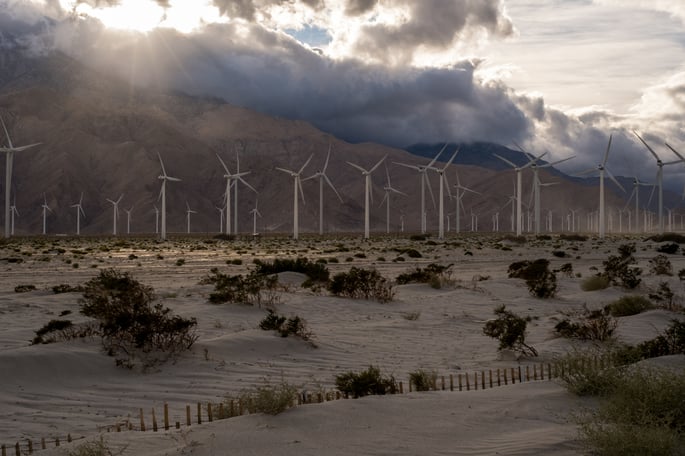As the global community increasingly adopts renewable energy sources like wind and solar, we're...
Addressing Curtailment and Congestion with Technology
In 2023, the United States has grappled with significant challenges related to energy curtailment and congestion, particularly in areas characterized by a high adoption of renewable energy sources, such as California and Texas.

In 2022, the California Independent System Operator (CAISO) reported a record curtailment of 2.4 million megawatt-hours (MWh) of solar and wind energy, with solar energy accounting for a substantial 95% of this curtailment. The primary causes of this curtailment are congestion, where the existing power infrastructure cannot transport the available energy, and oversupply, which occurs when electricity generation exceeds consumer demand. It is noteworthy that CAISO tends to curtail solar energy during the spring when electricity demand is relatively low due to mild temperatures and solar generation is high due to sunnier weather conditions. By July 2023, California had expanded its wind and solar capacity to 17.6 gigawatts (GW) and had plans to add 3 GW by the end of 2024.
In Texas, the lack of adequate transmission capacity to major cities such as Houston and San Antonio has resulted in curtailments, particularly during the evenings when wind energy generation is more prevalent. Texas lacks significant interconnection with other electricity networks, making it susceptible to shortages or curtailments when there is an imbalance between supply and demand within the state. The Electric Reliability Council of Texas (ERCOT) has observed a steady rise in the curtailment of both wind and solar energy, reaching 7.6 million MWh in 2022.
Expanding transmission lines in the United States is a complex and expensive undertaking. According to estimates by the American National Forum, the cost of upgrading the electricity transmission system to support the goal of achieving 100% carbon pollution-free electricity by 2035, as part of the Biden Administration's commitment, is projected to be approximately $2 trillion. This estimate encompasses the necessary expansion and modernization of the transmission infrastructure to transport carbon-free electricity to densely populated areas efficiently.
The approval and construction of new transmission lines entail many steps and can be time-consuming. It necessitates approvals from various federal, state, and local agencies and negotiations with private landowners. The complexity of this process varies depending on the scale of the transmission line. For instance, a short line utilizing an existing right-of-way along a federal highway is easier to gain approval than an interregional line traversing diverse land types and jurisdictions. This complexity often leads to protracted legal challenges from landowners and community groups, resulting in significant delays in project completion.
A pertinent example of these challenges can be found in a transmission line project in Maine, which was designed to supply hydropower to the New England grid. This project encountered numerous obstacles, including opposition from existing power generators, environmental organizations, and a citizen-led ballot initiative. Consequently, the project experienced substantial delays and a 50% cost increase compared to initial estimates.
The high rates of curtailment and transmission capacity limitations underscore the urgent need for innovative solutions. Artificial Intelligence (AI) emerges as a powerful tool to address these pressing issues, harnessing its capabilities in predictive analytics, grid optimization, and efficient management of energy resources.
Predictive Analytics for Enhanced Forecasting
AI can process and analyze vast volumes of data, enabling precise forecasting of energy demand and supply. This is especially valuable for renewable energy sources like solar and wind, which exhibit variable and unpredictable output. AI's predictive analytics can anticipate periods of oversupply or high demand, facilitating improved planning and reducing instances of energy curtailment. Accurate predictions also aid in achieving a balance between energy generation and consumption, ensuring efficient utilization of renewable energy.
Optimizing Grid Operations
AI algorithms excel in optimizing intricate systems, making them well-suited for managing complex power grids. In situations where power lines are congested, AI can identify the most efficient pathways for electricity distribution, mitigating bottlenecks and enhancing the overall capacity of the grid. This capability holds significant importance in states like California and Texas, where the geographical distance between renewable energy sources and urban centers presents a notable challenge.
Integration of Distributed Energy Resources
The emergence of Distributed Energy Resources (DERs), such as rooftop solar panels and battery storage, has added complexity to grid management. AI can play a pivotal role in integrating these diverse energy sources into the grid. By intelligently managing these various energy resources, AI contributes to grid stability and reduces the necessity for curtailment, particularly during periods of high renewable generation and low demand.
Real-Time Decision Making
AI's capacity for real-time decision-making and automated control is invaluable in managing the inherent variability of renewable energy sources. This rapid response is critical for ensuring maximum utilization of renewable energy and minimizing curtailment. AI systems can autonomously adjust control settings on grid equipment, responding promptly to fluctuations in supply and demand, thereby optimizing the efficiency of renewable energy usage.
Enhancing Communication and Coordination
Effective communication and coordination between grid operators and energy markets are paramount, particularly in Texas, where transmission capacity constraints and limited connectivity with other networks exacerbate curtailment challenges. AI can enhance these aspects by facilitating improved information exchange and coordination strategies, resulting in more efficient energy distribution and reduced curtailment.
Predictive Maintenance for Grid Resilience
AI also plays a pivotal role in the predictive maintenance of energy infrastructure. AI enhances the grid's resilience by anticipating potential failures and recommending timely maintenance. This aspect is crucial in preventing transmission constraints that could lead to energy curtailment.
In conclusion, energy curtailment and congestion have emerged as substantial challenges in the United States, especially in regions such as California and Texas, with high adoption of renewable energy sources. The expansion of transmission lines to address these challenges is a complex and costly endeavor, often marked by numerous approvals and delays. However, innovative solutions harnessing the power of Artificial Intelligence hold great promise. AI has the potential to enhance energy forecasting, optimize grid operations, integrate Distributed Energy Resources, enable real-time decision-making, improve communication and coordination, and enhance predictive maintenance. These AI-driven capabilities offer the opportunity to mitigate curtailment, maximize the utilization of renewable energy, and establish a more resilient and efficient energy infrastructure. Achieving these benefits necessitates collaborative efforts among stakeholders to usher in a sustainable energy future.
.jpg?height=200&name=iStock-1450272068%20(1).jpg)

